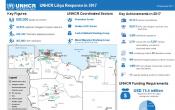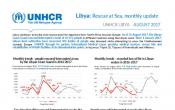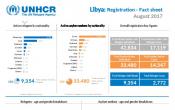Libya
Operation: Libya
Location
{"longitude":17,"latitude":27,"zoom_level":5}
Latest update of camps and office locations 21 Nov 2016. By clicking on the icons on the map, additional information is displayed.
Key Figures
| 2016 end-year results | |
| 8,300 | refugee households received core relief items or cash assistance |
| 5,200 | IDP households received core relief items or cash assistance |
| 825 | visits conducted to detention facilities by UNHCR and partners |
| 578 | individuals were released from detention centres following UNHCR and partners’ interventions |
| 16 | capacity-building events and trainings on refugee protection were organized for international and national NGOs and Libyan authorities |
| 2017 planning figures | |
| 8,000 | internally displaced families will receive core relief items |
| 8,000 | refugee families will receive core relief items or cash grants |
| 6,000 | new people of concern will be registered |
| 50 | border guards and government officials will be trained on refugee protection |
| 20 | advocacy interventions will be conducted to promote alternatives to detention and prevent arbitrary detention |
Latest Updates
As of 18 September 2017
People of Concern
41%
Increase in
2016
2016
| 2016 | 662,897 |
| 2015 | 471,653 |
| 2014 | 399,935 |

[["Refugees",9310],["Asylum-seekers",29237],["IDPs",174510],["Returned IDPs",449840]]
Loading ...
Libya
< Back
2016
{"categories":[2012,2013,2014,2015,2016,2017],"budget":[31.36360864,18.29967982,19.0845059,20.43036002,23.865039,72.39521681],"expenditure":[12.65725183,6.72035615,7.31457152,8.54921236,12.12147176,null]}
{"categories":[2012,2013,2014,2015,2016,2017],"p1":[14.43788523,13.34674547,16.6945059,18.21231402,18.82037598,59.93643981],"p2":[null,2.16251618,0.34,null,null,null],"p3":[null,null,null,null,null,null],"p4":[16.92572341,2.79041817,2.05,2.218046,5.04466302,12.458777]}
{"categories":[2012,2013,2014,2015,2016,2017],"p1":[8.09127234,6.09107143,6.90089752,6.71457381,9.79650861,null],"p2":[null,0.31574905,0.03065,null,null,null],"p3":[null,null,null,null,null,null],"p4":[4.56597949,0.31353567,0.383024,1.83463855,2.32496315,null]}
Loading ...
CHOOSE A YEAR
- 2015
- 2016
- 2017
Working environment
In 2016, Libya continued to experience political instability and armed conflict, which triggered internal displacement. Benghazi, Derna, Sabha, Tripoli, Ubari and Zintan are among the major cities affected.Libya remained the main gateway for mixed movements towards Italy. More than 90 per cent of the 180,000 sea arrivals to Italy in 2016 departed from Libya.
Humanitarian access continues to be a challenge. UNHCR has been operating remotely from Tunis, Tunisia since 2014 but is maintaining its presence inside Libya through national staff and partners. Short missions to Libya resumed in 2016.
Population trends
- 697,600 people of concern in Libya, including approximately 241,000 internally displaced people (IDPs), 356,000 IDP returnees and an estimated 100,000 refugees and asylum-seekers
- Of the estimated 100,000 refugees and asylum-seekers inside Libya, 38,670 are registered with UNHCR. They are mainly from the Syrian Arab Republic (50%), Palestine (15%), Eritrea (12%), Iraq (8%), Somalia (6%) and Sudan (6%)
- UNHCR resumed registration in December 2015 and registered 1,900 asylum-seekers in 2016
Achievements and impact
- UNHCR resumed registration and continued protection monitoring in Libya through its three community development centres (providing information, registration, counselling, health care and in-kind/cash assistance for refugees) home visits and phone hotlines.
- UNHCR maintained access to 15 detention centres, managed by the Department for Combatting Illegal Migration, to identify vulnerable cases, advocate for their release, and provide life-saving assistance.
- UNHCR established a presence in 5 disembarkation points and provided core-relief items and emergency health care to people intercepted/rescued at sea and disembarked in Libya.
Unmet needs
- Registration capacity was limited. Libyan authorities are supportive of UNHCR’s efforts to register persons from seven countries considered as “refugee producing” but there might be some other individuals in need of international protection.
- UNHCR activities in the eastern part of the country were hampered by new bureaucratic impediments and security conditions. Moreover, the expansion of UNHCR activities in the south was hampered by insecurity and logistical constraints. The distribution of cash assistance was affected by the liquidity crisis in Libya, as well as local regulations adopted by authorities.
- There is a need to develop practical arrangements for the reception of refugees and asylum seekers, in particular for children and vulnerable women, and to move away from the current detention paradigm.
Four years after the revolution, Libya continues to navigate a tumultuous transition period characterized by deep political divisions, heavy fighting, and rising insecurity and criminality.
There are some 37,000 registered asylum-seekers and refugees in Libya, originating mostly from Eritrea, Iraq, Somalia, the State of Palestine, Sudan and the Syrian Arab Republic. In addition there are over 435,000 internally displaced people (IDPs) in Libya.
Given the security situation, access and movements continue to pose operational challenges. Mixed movements towards Europe are likely to continue unabated through trafficking networks and smuggling routes.
Protection assistance to people of concern will continue through adapted modalities. Prioritized activities in 2016 will remain border monitoring, registration, provision of cash and core relief items, medical assistance, advocacy for alternatives to detention and lifesaving interventions in the context of mixed movements.
UNHCR will carry out limited refugee status determination and resettlement for extremely vulnerable people in need of durable solutions. Through expanded community outreach, the Office and its partners will detect and reduce protection risks faced by people of concern, in particular sexual and gender-based violence, through support to community-based protection mechanisms, development of referral mechanisms and awareness-raising. Focus will also be on supporting IDP returnees and refugees/asylum seekers in urban areas and work on protection sensitive border management in response to mixed movements, as well as continued efforts to find alternative solutions to detention.
Activities affected by lack of funding in 2016 will include efforts to strengthen child protection services, provide core relief items; enhance registration, and conduct detention centre monitoring.






